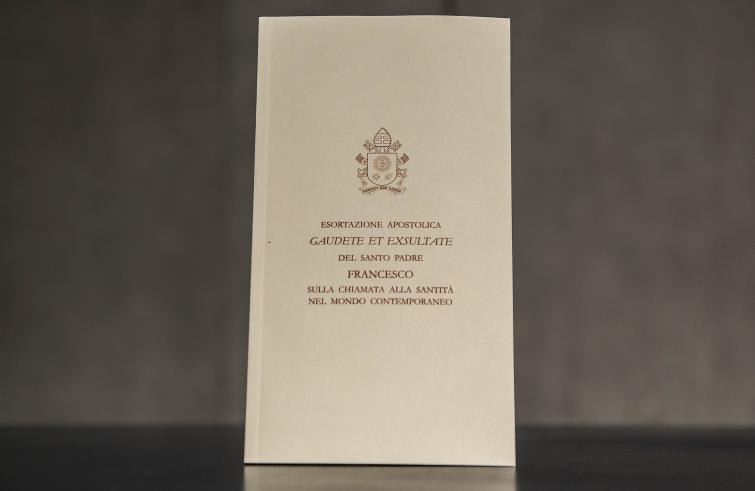
“Gaudete et exsultate”, Pope Francis’ new apostolic exhortation “on the call to holiness in today’s world” develops along two strictly-related tracks: the mystical and ascetical Catholic tradition on the one side, and its prophetic re-evaluation and reformulation on the other. The former emerges constantly not only in quotations from theologians and saints – from the Church Fathers to Balthasar, to Thomas Aquinas – adorning the text, but also in several significant expressions of faith experience and the holiness attained as its zenith. For example: “The Christian life is a constant battle” (n. 158), is an expression that echoes the title of a classical text of Catholic literature that flourished between the late 16th century and the early 17th century: the Spiritual Combat by Fr Lorenzo Scupoli, an oeuvre that closely relates to the ‘militant’ outlook of the Society of Jesus founded by Ignazio di Loyola. Moreover, the continuation of this page appears to be written at the time of Saint Ignatius: “We need strength and courage to withstand the temptations of the devil and to proclaim the Gospel.” Another example: in summarising the criteria whereby the exercise of Christian virtues of candidates to the honour of the altars in beatification and canonization processes, the Pope tells us that saints’ life is “an exemplary imitation of Christ, one worthy of the admiration of the faithful.” It’s another expression that evocates a common expression in beatification processes from the Middle Ages until the first decades of the 20th century, namely:
the saint that ‘heroically’ reproduces the image of Jesus in himself, is “admirable more than imitable.”
However, in Francis’ exhortation the connection – that is also terminological – with tradition, is accompanied by a new conspicuous tension that gives contemporary relevance to the same tradition, thereby eliminating the risk of becoming a ‘museum piece’ (cf. n. 58) and establishing a bond with unprecedented situations experienced by contemporary faithful who follow the path of the Gospel. That’s why Francis teaches us that the Saints’ faithfulness to the Gospel is to be imitated, not only admired, as in truth the Gospel itself is re-enacted in its multifarious, unlimited nuances. At the same time, the “friends of God” are admirable more than imitable for us, for the universal vocation to holiness is always personal, individually customised, and thus singular and peculiar, expressed in what we could consider as our spiritual fingerprints. While it is given to all the baptised with no exclusion, as we learn in the Council document Lumen gentium, it remains the “unique and mysterious plan that God has for each of us” (n. 170). Thus admiration does not lead us to imitate the saints of the past but to live in turn – with widespread personal commitment and with the creativity bestowed upon us by the Holy Spirit – the call to be saints ourselves, with the tone of our voice as it proclaims the Gospel and with our facial features that reverberate its light. Caught in the tension between innovation and tradition,
“Gaudete et exsultate” is more an outline for a course of spiritual exercises, than a weighted document of Church Magisterium.
More precisely, it’s a lively spiritual conversation that Francis undertake with every reader of his exhortation: the use of the second-person singular, constantly referring to the reader of the Pope’s beautiful pages as “you”. The bibliographic references, listed in the closing footnotes, lead us to believe that perhaps those were actually notes that the Pope had brought to Rome from Argentina, where he certainly held many spiritual retreats, both at individual and at community level. With this remark I don’t intend to bring to mind certain papers yellowed with time. Instead, what I intend to say, is that the apostolic exhortation contains the essence of a long standing experience, lived in first person by its author, verified on multiple occasions in the decisive moments of his life and in the relationship with the people he met, accompanied, guided along the paths of the Gospel. A veritable ‘spiritual grappa’ very high in alcohol. Not mere annotations to repeat – once more – a course in spiritual exercises but a new path of life to be finally undertaken, once and for all. The signposts of this journey are precious indications for us all: The ordinariness of holiness, which is a matter of daily life, involving the relationships that we establish with others and with God, the work we do, the concrete ways in which we are living the public and private spheres; the community and personal dimensions of holiness, lived in first person while constantly relating to everyone, in the married couple, in the family, in religious communities, in groups and in ecclesial associations, in the liturgical assembly and in the Eucharistic celebration; the inductive, or historical, character of holiness which, although sown in our existences from on high as a gift of grace, sprouts in from the grassroots, depending on the ‘soil’ that each of us decides to be for it.It could be said that Francis has announced the new rules that initiate beatification processes. However, said rules do not replace the earlier ones, starting with the beatitudes, that remain “the identity card of Christians” (n. 63). However, they prompt self-verification we are all called to undertake. The Pope illustrates them in the fourth chapter that highlights “the signs of holiness in today’s world.” These are: “perseverance, patience and meakness”, “joy and sense of humour”, “boldness and passion”, an approach “in community”, and “constant prayer.” Thus holiness becomes a concrete possibility at everyone’s reach.










